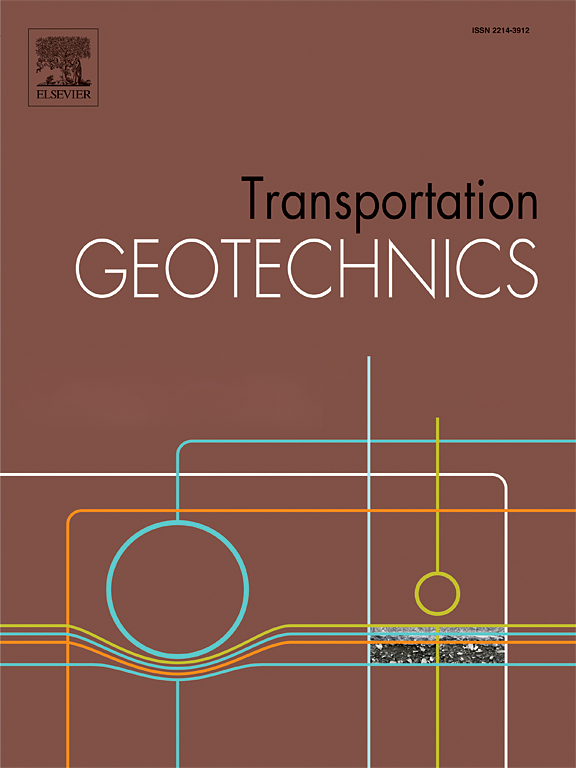Investigating the seepage-thermal interaction process on the thermal stability of highway embankments in permafrost regions adjacent to thermokarst lakes
IF 4.9
2区 工程技术
Q1 ENGINEERING, CIVIL
引用次数: 0
Abstract
The hydrological process of a thermokarst lake plays a pivotal role in the thermal stability of nearby embankments through its considerable influence on thermal in permafrost areas. However, simply treating a thermokarst lake as a heat source has hindered the understanding of the seepage effect during thermal erosion. Moreover, the mechanism by which the seepage process affects the thermal state of permafrost remains uncertain. Here, we conducted an investigation and collected monitoring data at an embankment–thermokarst lake comprehensive observation site on the Qinghai–Tibet Plateau. The monitoring data indicate that the geotemperature distribution in the embankment exhibited remarkable asymmetrical characteristics. Notably, the proximity of the ground to the thermokarst lake resulted in greater geotemperatures and higher water contents. A puzzling phenomenon was observed whereby the embankment away from the thermokarst lake exhibited a deeper permafrost table, demonstrating a deviated thawing bowl below the embankment. We employed a seepage–thermal coupling model to demonstrate that the seepage process profoundly affects the geotemperature distribution pattern. The simulation results reveal that the convection heat flux from water flow dominated the total flux, gradually causing a deeper permafrost table along the flow path. Hence, the permafrost table decreased during seepage, which is consistent with the monitoring data, generating a deviated thawing bowl away from the thermokarst lake. It is important to consider the seepage–thermal coupling effect to assess the thermal stability of embankments beyond thermokarst lakes accurately.
热岩溶湖附近多年冻土区公路路堤热稳定性的渗-热相互作用过程研究
热岩溶湖的水文过程通过对多年冻土区的热影响,对附近河堤的热稳定性起着举足轻重的作用。然而,简单地将热岩溶湖作为热源,阻碍了对热侵蚀过程中渗流效应的理解。此外,渗流过程对冻土热状态的影响机制尚不明确。本文在青藏高原的一个河堤-热岩溶湖综合观测点进行了调查和监测。监测数据表明,路堤地温分布具有明显的不对称特征。值得注意的是,地面靠近热岩溶湖导致了更高的地温和更高的含水量。观察到一个令人费解的现象,即远离热岩溶湖的路堤显示出更深的永久冻土,表明路堤下方有一个偏离的融化碗。采用渗流-热耦合模型分析了渗流过程对地温分布格局的深刻影响。模拟结果表明,水流对流热通量在总通量中占主导地位,并逐渐导致沿流动路径的多年冻土层变深。因此,在渗流过程中,多年冻土水位下降,这与监测数据一致,形成了一个偏离热岩溶湖的融化碗。考虑渗-热耦合效应是准确评价热岩溶湖外堤防热稳定性的重要因素。
本文章由计算机程序翻译,如有差异,请以英文原文为准。
求助全文
约1分钟内获得全文
求助全文
来源期刊

Transportation Geotechnics
Social Sciences-Transportation
CiteScore
8.10
自引率
11.30%
发文量
194
审稿时长
51 days
期刊介绍:
Transportation Geotechnics is a journal dedicated to publishing high-quality, theoretical, and applied papers that cover all facets of geotechnics for transportation infrastructure such as roads, highways, railways, underground railways, airfields, and waterways. The journal places a special emphasis on case studies that present original work relevant to the sustainable construction of transportation infrastructure. The scope of topics it addresses includes the geotechnical properties of geomaterials for sustainable and rational design and construction, the behavior of compacted and stabilized geomaterials, the use of geosynthetics and reinforcement in constructed layers and interlayers, ground improvement and slope stability for transportation infrastructures, compaction technology and management, maintenance technology, the impact of climate, embankments for highways and high-speed trains, transition zones, dredging, underwater geotechnics for infrastructure purposes, and the modeling of multi-layered structures and supporting ground under dynamic and repeated loads.
 求助内容:
求助内容: 应助结果提醒方式:
应助结果提醒方式:


